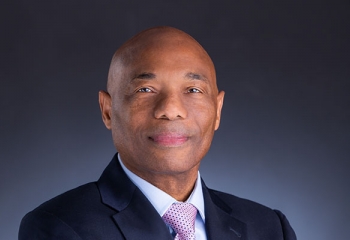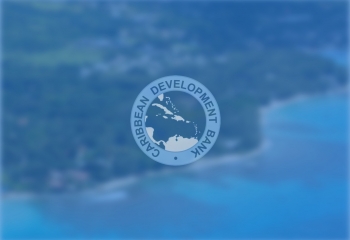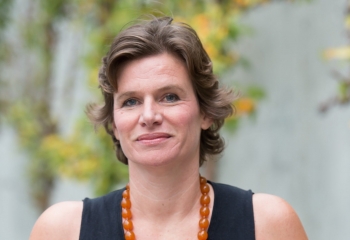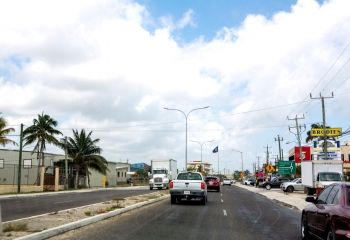Keynote Address: The 52nd General Assembly of the Caribbean Broadcasting Union
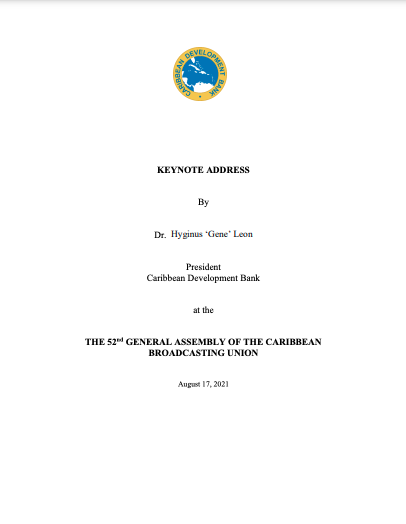
INTRODUCTION
It is an honour and privilege to deliver this keynote address at your 52nd General Assembly.
The Caribbean Broadcasting Union (CBU), like the Caribbean Development Bank (CDB), was founded in 1970 as one of the key organs of regional integration. Having passed the symbolic and significant half century mark, the CBU can, like us at CDB, contemplate its evolution and the lessons that could anchor its role over the next fifty years.
Like at CDB, I think that contemplation can reenergise your resolve to realise the key objectives of your mandate - promoting a free and active media industry that upholds standards and policies and contributes to regional integration through the provision of reliable information.
At the risk of losing the opportunity for a punchline, let me state a few key themes that I believe would be suggested by a reflection on our past and potential future:
- Development is a holistic concept. To discover and find apt solutions, we have to focus on the internal integrity of the development ecosystem, ensuring consistency among its interacting dimensions;
- In the absence of an omniscient central planner, development boils down to joint responsibility for implementing purpose-driven national and regional goals; and
- Communications, as a tool, needs to be placed alongside mainstream development policies – akin to intentional economic and social policies.
To be provocative, what if you could buttress progress achieved in advocating for a free and active media with a responsibility to inform and help promote development by influencing the social psyche through the active management of content? What if you could not simply passively report on events, but actively help create those events that you would be reporting on?
So, where does this reflection begin?
No doubt, as members of CBU, you (like CDB) are also actively considering how your organisation can more effectively serve its stakeholders and remain relevant for the next half century and beyond. It is clear to us at CDB, and I hope to you also, that for any of us to see that milestone, we will have to successfully negotiate the rescue and recovery of our Region’s economies and social fabric in the wake of setbacks caused by the COVID-19 pandemic; overcome the structural weaknesses that existed before the pandemic; and reposition our economies to become secure, high productivity, competitive, and resilient so that our people can confidently choose it as the place for living.
Development Ecosystem
The COVID-19 pandemic has had a profound impact on CDB’s Borrowing Member Countries. Indeed, all but one of these countries suffered contractions in Gross Domestic Product (GDP) in 2020; and of these, 13 recorded double-digit declines. This translated into significant loss of livelihoods, unemployment, and social dislocation. To a large extent, the significant challenges our Region faced prior to the onset of the pandemic became more acute. As we undergo rescue and recover, we must address those underlying structural challenges that created the vulnerabilities which make us susceptible to shocks.
Ultimately, we must make the Region more resilient across five foundational dimensions. Specifically, we must foster:
- social resilience;
- production resilience;
- financial resilience;
- environmental resilience; and
- institutional resilience.
While they are all important for systemic integrity, binding constraints require prioritisation and a structured approach, over time, to ensure no dimension is left behind or left unaddressed. This can only be achieved through innovation, defined as the development and application of ideas and technologies that improve goods and services or make their production more efficient.
Let me elaborate these aspects of the dimensions of a healthy development ecosystem, before addressing the role of the communications sector in the development process by reference to some topical social issues as examples.
The first element of a healthy development ecosystem is social resilience. This relates to the capacities of individuals, communities and societies to secure their well-being in the face of challenges, and is ultimately about leaving no one behind. Social resilience speaks to the removal of barriers that might prevent individuals from reaching their full potential. It involves the ability to obtain an education, to be healthy, and to access services, such as water and sanitation. In this regard, there is much progress to be made.
The second element of a wholesome development ecosystem is production resilience, which speaks to the ability of a country to withstand or recover from an economic shock. The experience has been that our countries are acutely susceptible to exogenous economic shocks. Indeed, the vulnerability drag or persistence and duration of the impact of shocks has been higher in our countries than in other small states. If we consider the impact of the previous global shock – the Great Recession – we observe that after declining in 2009, it took four years for the total real GDP of our borrowing member countries to reach the 2008 level. Significantly, two countries are yet to return to that real level of GDP; one country took ten years; three took nine years; and one took eight years.
By contrast, and using the United Nations’ definition of small states, total GDP of other small states did not fall in 2009. Building production resilience will require that our Region take steps to increase competitiveness and promote innovation that spurs diversification.
The third component of the development ecosystem is financial resilience, which relates to building financial buffers, insuring assets, securing strong financial management, using risk transfer instruments and taking cognisance of risks. Given the exposure of financial and non-financial assets in the Region to shocks, financial resilience is critical to the overall development ecosystem.
The fourth element is environmental resilience. Our Region is among the most susceptible to natural hazard events and the impacts of climate change. Natural hazard events disrupt lives and livelihoods, and erode the development gains. At the same time that the Region lags comparator country groups, natural hazard events set back development even further by destroying social and economic capital while also reducing the productivity of such capital.
The fifth element – institutional resilience – has to do with the institutional capacity to drive and sustain development. Institutions govern the rules by which interactions take place in society. In a 2002 study, Rodrik et al assessed institutions as the most significant determinant of the difference in development across countries. Protection of property rights, effective law enforcement and efficient bureaucracies, together with a wide spectrum of civic mores and norms, have been found to exert strong causation on development, over time.
Role of Communications
While we speak openly of the roles of government, of the private sector, of international and regional institutions like CDB in the process of development, we have not emphasised adequately, in my opinion, the critical role that the communications community in this Region has to play in this journey.
Development will not be achieved merely through the crafting of plans and policies. It will require disciplined implementation and accountability, which in turn implies a change in the social psyche toward adopting a growth mindset.
This is where you as communications practitioners enter the picture. This sector must own the responsibility of being integral to the development objectives and agenda of our Region and align its messaging accordingly. Your role should transcend reporting on events of development. I would argue that it should include the ability to highlight the necessities and explain the implications of events in a manner that can influence change in the psyche of our people.
In essence, you need to be in the forefront supporting and promoting concepts of economic growth, stability, and social cohesion that are necessary for the continued development of our Region. To effect this vision, we need partnership and joint responsibility, forging ahead together to achieve purpose-driven goals.
As the Fourth Estate, the media’s role in promoting inclusive growth and development is well understood . The literature is replete with studies indicating the nexus between the media and desirable development outcomes, such as good governance, improved economic efficiency and stability, enhanced social cohesion, and environmental resilience. Our present reality demands an enhanced approach; and we can start by reimagining how we tell our stories.
Let me illustrate in a couple of topical areas, specifically education and youth development.
With the spread of the disease, more than 6.6 million students and almost 230,000 teachers have been adversely impacted by school closures, interruptions in learning, and the postponement, cancelation or revision of examinations. This loss has been more profound for students from disadvantaged socio-economic circumstances; persons with disabilities; and those who were already experiencing learning deficits before the onset of the pandemic.
Estimates of learning loss in various jurisdictions range from six to 16 months, depending on the severity and frequency of lockdowns, the inability of households to provide the basic means for children to participate meaningfully in online learning, and the unpreparedness of education systems. The cumulative impact of this deficit, unless arrested and reversed, could result in cumulative underachievement and a generation of learners failing to realise their educational potential.
How can the communications sector assist in bridging the digital divide and help promote an expansive online presence that can reach students with limited access to education services?
I suggest consideration of a partnership with the education sector through which learning can harness the multimodal delivery tools in the communications sector, to broaden reach across cohorts of students and even overcome the estimated 16-month learning loss from COVID-19. This type of partnership, for example, can facilitate the replicative teaching of mathematics across several school jurisdictions, using the same best practice pedagogy pioneered by our most gifted mathematics teachers.
The second area I want to touch on is youth development.
According to 2020 estimates, over 40% of the population is less than 24 years old. Reports on this group which make up our Region’s youth often focus on their disproportionate representation among the poorest and most vulnerable and on their involvement in anti-social activities. They are more often portrayed negatively rather than positively in communities, in youth-targeted interventions, and in the media. This Deficit Model of youth development views them as “problems to be managed”. The negative stereotypes of their behaviours and attitudes often undersell the fact that this group also represents young people who are energetic, creative, and innovative and who have a pivotal role to play in societal transformation. Providing an enabling environment for the full realisation of youth rights and capabilities is essential for self-actualisation and helping the Region to leverage a demographic dividend as well as to achieve the Sustainable Development Goals.
At CDB’s Annual Meeting in June this year, the virtual Youth Forum had, by far, the most viewership, engagement, and participation. The success of this event can be attributed to the direct involvement of youth in the design and implementation of the forum, the positive messages and stories discussed, and the desire of young people to participate in the development process.
As you are aware, the media plays a critical role in shaping youth ideas and beliefs. As such, you have a huge responsibility to present content that is balanced and purposive, promoting an approach where young people are recognised for their strengths, capabilities, and resources.
Another area which requires your immediate attention is gender-based violence.
Over the past year, the world has witnessed a rise in gender-based violence cases, which many now refer to as the "shadow pandemic." Before the COVID-19 pandemic, the Caribbean was already experiencing above average rates of gender-based violence; and the 2021 Status of Men and Women Report for the Caribbean has highlighted that these incidents increased significantly with the pandemic. If unaddressed, this problem will continue to cripple our socio-economic conditions and stifle economic growth.
Again, the media can be a significant partner for protecting the rights of vulnerable populations. It can provide thought leadership, set the regional policy agenda, and influence public perceptions on gender-based violence. This translates to raising awareness and informing on the social and economic implications of such issues. It also means creating insights that can educate the public and debunk myths, while shaping positive attitudes and behaviours that can eventually eliminate gender-based violence.
Let me turn briefly to some thoughts on the importance of transformation for your core business.
Over the last two decades, traditional media has faced an array of challenges and opportunities stemming from the digital revolution. From social networks to mobile applications and virtual realities, the digital shift has triggered major change in business, politics, society and culture; and traditional media has been significantly impacted by the changing trends.
Reflection on changes expected in the future and repositioning to be fit-for-purpose is probably inescapable. Undertaking your own digital transformation will likely imply changes in mindset and organisational culture to reconfigure your business models and build digital competences.
Beyond process adaptation, opportunities for innovation can arise in challenging the limits arising from national boundaries and embracing unlimited boundaries from digital transformation. I refer to opportunities for e-commerce, for creating and transmitting content to audiences that access multiple channels through internet connectivity, more affordable mobile technology, and digital and social media. As you are aware, the ease and accessibility of technology has created countless individual content and media producers who are competing with large, professional media outfits for audience share and attention. So, product innovation, early mover advantage, and niche markets will feature in this sector’s positioning for the future.
Adaptation and agility will also be critical. A case in point is Spaces, the Twitter-based audio streaming platform, which was used by the two main political parties in Saint Lucia to host audio town hall meetings during the campaign for the recent general election. The pivoting from radio broadcasts recognised that social media platforms have proved to be more effective in reaching millennials and Generation Z audiences. It also serves to highlight the growing role of evidence-based analysis in decision making.
It appears that your own transformation will need to balance evolving needs of audiences, which are pointing to timely, accurate, credible, and easily digestible, and visually impactful content. Needless to add that you will, through these innovations, contribute to economic diversification and economic growth.
CDB and The Regional Media
In closing, let me address one final point – CDB and the regional media. I see numerous opportunities for and would like to invite you to partner in enhancing our collaboration.
There is scope for supporting capacity building to help the media to develop a better understanding of issues affecting development and to improve the reporting and analysis of development financing. CDB also wants to encourage increased reporting on the work of regional organisations, with quality content that will foster greater cohesion within the Caribbean Community.
We are eager to partner in providing training to upskill reporters, editors and content creators to utilise digital channels more effectively for presenting development and financial data in engaging ways.
CBU, as a leading Pan-Caribbean medium, has an important role to play in raising awareness of key issues, in highlighting national and regional accomplishments for positive reinforcement, and in promoting dialogue between leaders and citizens. Indeed, you are well placed to the bring together diverse groups, be they in Vieux Fort in Saint Lucia, Mandeville in Jamaica, or the diaspora.
Your track record in deepening the integration process must be lauded and some of the content created for viewership across the Region such as CaribScope, Caribbean Newsline, and Talk Caribbean are highly rated. However, your audiences now expect and demand enticing inter-communication experiences.
There is ample room for a deeper partnership between the media and regional organisations, like CDB. Our efforts must not cease in advocating regional development and the deepening of regional integration. Let today’s event be the start of a regular dialogue on how we can be more effective in our service to the people and institutions of the Caribbean.
